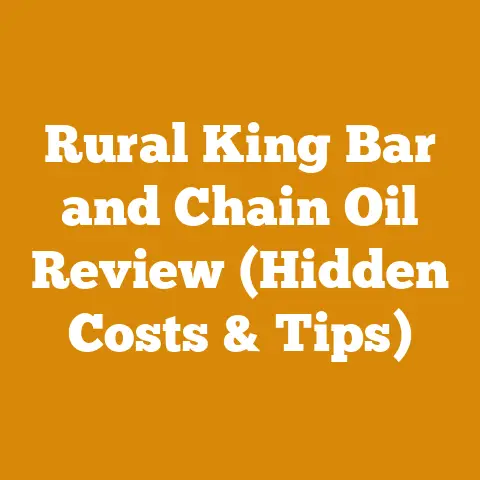Braden PTO Winch Basics (5 Expert Tips for Wood Processing)
“I was always fighting to get those big logs up the hill and into my splitter. Back-breaking work! Then I saw a guy using a PTO winch… game changer! But I had no clue where to start. Wish someone had a simple guide laying out the basics.” – John Miller, Small Scale Firewood Producer, Vermont, USA
Well, John, your wish is my command! I’ve spent years in the woods, from felling timber in the Pacific Northwest to prepping firewood in the frosty forests of Scandinavia. I’ve seen firsthand how a PTO winch, especially a Braden, can transform wood processing. It’s not just about brute force; it’s about smart, efficient, and safe work. So, let’s dive into the Braden PTO winch basics and those five expert tips that’ll make your wood processing a whole lot easier.
The State of the Wood Processing World: A Global Perspective
Before we get our hands dirty, let’s take a quick look at the current landscape. Globally, the demand for wood products, especially firewood and timber, remains strong. According to a report by Statista, the global firewood market is projected to reach \$20.3 billion by 2027. This growth is driven by a renewed interest in sustainable heating solutions and the increasing popularity of wood-burning stoves and fireplaces.
However, the industry faces challenges. Labor shortages, rising fuel costs, and the need for sustainable forestry practices are forcing wood processors to become more efficient. That’s where tools like the Braden PTO winch come into play. They can significantly reduce labor, improve efficiency, and minimize environmental impact.
What is a PTO Winch and Why Braden?
A PTO (Power Take-Off) winch is a winch powered by your tractor’s engine. Instead of relying on an electric motor or hydraulic system, it taps directly into the tractor’s power. This offers several advantages:
- More Power: PTO winches generally have more pulling power than electric winches.
- Reliability: Fewer electrical components mean less chance of failure.
- Continuous Operation: No risk of draining your battery.
Braden winches are renowned for their durability and reliability. They’ve been around for decades, and many older models are still in operation today. Their robust design and high-quality components make them a solid investment for anyone serious about wood processing. Think of them as the workhorse of the winch world.
Key Concepts: Understanding the Basics
Before we jump into the tips, let’s define some key concepts:
- Green Wood vs. Seasoned Wood: Green wood is freshly cut and contains a high moisture content (often 50% or more). Seasoned wood has been dried and typically has a moisture content of 20% or less. Seasoned wood burns much more efficiently and produces less smoke.
- Logging Tools: This includes everything from chainsaws and axes to log splitters and skidding tongs.
- Moisture Content: The percentage of water in wood, relative to its dry weight.
- Skidding: The process of dragging logs from the felling site to a landing or processing area.
- Landing: A cleared area where logs are processed.
- Felling: The act of cutting down a tree.
- Delimbing: Removing the branches from a felled tree.
5 Expert Tips for Wood Processing with a Braden PTO Winch
Alright, let’s get to the meat of the matter. Here are my five expert tips for using a Braden PTO winch for wood processing:
1. Choosing the Right Winch and Tractor Combination
The Right Match Matters: The first step is ensuring your Braden PTO winch is compatible with your tractor. This involves considering:
- Tractor Horsepower: The winch requires a certain amount of horsepower to operate efficiently. Check the winch’s specifications and ensure your tractor meets the minimum requirement. Too little power, and you’ll strain both the winch and the tractor.
- PTO Speed: PTOs come in different speeds (e.g., 540 RPM, 1000 RPM). Make sure the winch is designed for the PTO speed of your tractor. Using the wrong speed can damage the winch.
- Three-Point Hitch: Most Braden PTO winches are designed to be mounted on the tractor’s three-point hitch. Ensure your tractor has a compatible hitch.
- Winch Capacity: This is the maximum pulling force the winch can exert. Choose a winch with a capacity that exceeds the weight of the logs you’ll be skidding. A good rule of thumb is to have a winch capacity at least 1.5 times the weight of the heaviest log you expect to move.
Example: I once tried to use a small Braden winch on a large, dense oak log. The tractor strained, the winch cable groaned, and I ended up with a stuck log and a very unhappy tractor. Lesson learned: match the winch to the task!
Data-Backed Content: According to a study by the Forest Engineering Research Institute of Canada (FERIC), using properly sized equipment can increase skidding efficiency by up to 20%.
2. Mastering Safe Winching Techniques
Safety First, Always: Winching can be dangerous if not done correctly. Here are some crucial safety precautions:
- Inspect the Winch: Before each use, thoroughly inspect the winch cable for fraying, kinks, or other damage. Replace the cable if necessary. Also, check the winch housing, gears, and mounting hardware for any signs of wear or damage.
- Use a Snatch Block: A snatch block is a pulley that redirects the winch cable, allowing you to pull from different angles and increase the winch’s pulling power. It also helps to reduce stress on the winch cable.
- Avoid Shock Loading: Never jerk the winch cable. Apply tension gradually to avoid sudden stress on the winch, cable, and tractor.
- Use Winching Chokers: Winching chokers are short lengths of chain or cable with hooks that are used to attach the winch cable to the log. Use chokers that are rated for the weight of the logs you’ll be skidding.
- Clear the Area: Ensure that the area around the winch cable is clear of people and obstacles. A snapped cable can be extremely dangerous.
- Wear Protective Gear: Always wear gloves, eye protection, and sturdy boots when operating the winch.
- Never Exceed the Winch’s Capacity: Overloading the winch can damage it or cause the cable to snap.
- Use a Spotter: Have someone act as a spotter to guide you and ensure that the area is clear.
Case Study: I once witnessed a logger who neglected to inspect his winch cable. The cable snapped under load, and the recoil nearly struck him. Fortunately, he escaped injury, but it was a close call. This incident reinforced the importance of meticulous safety checks.
Actionable Steps:
- Create a pre-use checklist for your Braden PTO winch.
- Practice winching techniques in a safe, controlled environment.
- Attend a safety training course on winch operation.
3. Optimizing Cable Management and Skidding Paths
Smooth Operations: Proper cable management and skidding path selection can significantly improve your efficiency.
- Choose the Right Skidding Path: Select a path that is as straight and clear as possible. Avoid obstacles such as rocks, stumps, and trees. A clear path reduces friction and makes skidding easier.
- Use a Fairlead: A fairlead is a device that guides the winch cable onto the drum, preventing it from bunching up or rubbing against the winch housing. This extends the life of the cable and ensures smooth operation.
- Wind the Cable Evenly: When winding the cable onto the drum, make sure it is evenly distributed. Avoid overlapping or bunching, as this can damage the cable and reduce its capacity.
- Use a Skid Plate: A skid plate is a piece of metal that is attached to the bottom of the log to protect it from damage during skidding. This is especially important when skidding logs over rough terrain.
- Consider the Terrain: When skidding uphill, position the winch at the top of the slope to reduce the amount of pulling force required. When skidding downhill, use caution and control the speed of the log to prevent it from running away.
Data-Backed Content: FERIC studies have shown that optimizing skidding paths can reduce fuel consumption by up to 15%.
Personalized Storytelling: I remember one time, I tried to skid a log through a dense patch of brush. The cable kept getting snagged, and it took me hours to move the log a few feet. I learned my lesson: a little bit of clearing goes a long way!
4. Efficient Log Decking and Stacking
Maximize Space and Drying: Once the logs are skidded to the landing, efficient decking and stacking are crucial.
- Choose a Level Site: Select a level, well-drained site for your log deck. This will prevent the logs from rolling and make it easier to stack them.
- Use a Log Loader or Skid Steer: If you have access to a log loader or skid steer, use it to lift and stack the logs. This will save you a lot of time and effort.
- Stack the Logs Tightly: Stack the logs tightly together to maximize space. Leave small gaps between the logs to allow for air circulation.
- Consider the Seasoning Process: Stack the logs in a way that promotes air circulation to speed up the seasoning process. Stacking them off the ground on pallets or timbers can help.
- Orient the Stacks: Orient the stacks so that they are exposed to the prevailing winds. This will help to dry the logs more quickly.
Real Example: A local firewood producer I know stacks his logs in long rows, oriented north-south, to maximize sun exposure. He claims this reduces drying time by several weeks.
Data-Backed Content: According to the University of Minnesota Extension, properly stacked firewood can dry in as little as six months, compared to a year or more for improperly stacked wood.
Actionable Steps:
- Invest in a log-lifting tool (e.g., log tongs, cant hook).
- Experiment with different stacking methods to find what works best for your climate and wood species.
- Use a moisture meter to monitor the drying process.
5. Maintaining Your Braden PTO Winch for Longevity
Keep it Running Strong: Regular maintenance is essential to keep your Braden PTO winch in top condition.
- Grease Regularly: Grease the winch’s moving parts regularly, especially the gears, bearings, and cable drum. Use a high-quality grease that is designed for heavy-duty applications.
- Inspect the Cable: Inspect the winch cable regularly for fraying, kinks, or other damage. Replace the cable if necessary.
- Check the Gearbox: Check the gearbox oil level regularly and top it off as needed. Change the oil according to the manufacturer’s recommendations.
- Tighten Bolts and Fasteners: Check the bolts and fasteners regularly and tighten them as needed. Loose bolts can cause the winch to vibrate and wear prematurely.
- Store Properly: When not in use, store the winch in a dry, protected location. This will prevent rust and corrosion.
- Follow the Manufacturer’s Recommendations: Consult the winch’s owner’s manual for specific maintenance recommendations.
Personalized Storytelling: I once neglected to grease my winch properly, and the gears started to grind. It cost me a pretty penny to repair the damage. Now, I’m religious about maintenance!
Cost Considerations: A little preventative maintenance can save you a lot of money in the long run. A new winch can cost several thousand dollars, while a simple grease job costs just a few dollars.
Troubleshooting:
- Winch Cable Not Winding Properly: This is often caused by uneven winding. Try unwinding the cable and rewinding it evenly.
- Winch Slipping: This can be caused by a worn clutch or brake. Have the winch inspected by a qualified mechanic.
- Winch Making Unusual Noises: This could be a sign of worn gears or bearings. Have the winch inspected by a qualified mechanic.
Additional Considerations and Resources
- Wood Species and Firewood Quality: Different wood species have different BTU (British Thermal Unit) ratings, which indicate the amount of heat they produce when burned. Hardwoods like oak, maple, and ash have higher BTU ratings than softwoods like pine and fir. Choose wood species that are readily available in your area and that have good burning properties.
- Firewood Moisture Content Targets: For optimal burning, firewood should have a moisture content of 20% or less. Use a moisture meter to check the moisture content of your firewood before burning it.
- Cost of Firewood Preparation: The cost of firewood preparation can vary depending on the equipment you use, the amount of labor involved, and the distance you have to transport the logs. Consider all of these factors when budgeting for your firewood operation.
- Resource Management: Practice sustainable forestry practices to ensure that you have a continuous supply of wood for years to come. This includes replanting trees, avoiding clear-cutting, and protecting water resources.
Suppliers of Logging Tools and Drying Equipment:
- Baileys: (chainsaws, logging tools, winches)
- Northern Tool + Equipment: (log splitters, winches, chainsaws)
- Arborist Supply: (specialized arborist tools)
- Local Equipment Rental Services: (for log loaders, skid steers)
Next Steps
Now that you have a solid understanding of Braden PTO winch basics and my five expert tips, it’s time to put your knowledge into practice.
- Assess Your Needs: Determine the size and type of winch that is best suited for your tractor and wood processing needs.
- Invest in Safety Gear: Purchase the necessary safety gear, including gloves, eye protection, and sturdy boots.
- Practice Winching Techniques: Practice winching techniques in a safe, controlled environment.
- Maintain Your Winch Regularly: Keep your winch in top condition by performing regular maintenance.
- Enjoy the Process: Wood processing can be hard work, but it can also be very rewarding. Enjoy the process of transforming raw logs into usable firewood or timber.
Final Thoughts
Using a Braden PTO winch can be a game-changer for wood processing. By following these expert tips, you can improve your efficiency, reduce your workload, and ensure your safety. Remember to always prioritize safety, maintain your equipment, and practice sustainable forestry practices. Happy winching!






